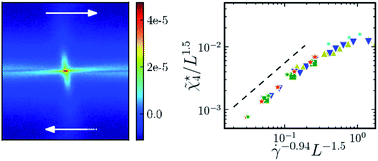Universal and non-universal features in coarse-grained models of flow in disordered solids
Abstract
We study the two-dimensional (2D) shear flow of amorphous solids within variants of an elastoplastic model, paying particular attention to spatial correlations and time fluctuations of, e.g., local stresses. The model is based on the local alternation between an elastic regime and plastic events during which the local stress is redistributed. The importance of a fully tensorial description of the stress and of the inclusion of (coarse-grained) convection in the model is investigated; scalar and tensorial models yield similar results, while convection enhances fluctuations and breaks the spurious symmetry between the flow and velocity gradient directions, for instance when shear localisation is observed. Besides, correlation lengths measured with diverse protocols are discussed. One class of such correlation lengths simply scale with the spacing between homogeneously distributed, simultaneous plastic events. This leads to a scaling of the correlation length with the shear rate as ![[small gamma, Greek, dot above]](https://www.rsc.org/images/entities/i_char_e0a2.gif) −1/2 in 2D in the athermal regime, regardless of the details of the model. The radius of the cooperative disk, defined as the near-field region in which plastic events induce a stress redistribution that is not amenable to a mean-field treatment, notably follows this scaling. On the other hand, the cooperative volume measured from the four-point stress susceptibility and its dependence on the system size and the shear rate are model-dependent.
−1/2 in 2D in the athermal regime, regardless of the details of the model. The radius of the cooperative disk, defined as the near-field region in which plastic events induce a stress redistribution that is not amenable to a mean-field treatment, notably follows this scaling. On the other hand, the cooperative volume measured from the four-point stress susceptibility and its dependence on the system size and the shear rate are model-dependent.


 Please wait while we load your content...
Please wait while we load your content...